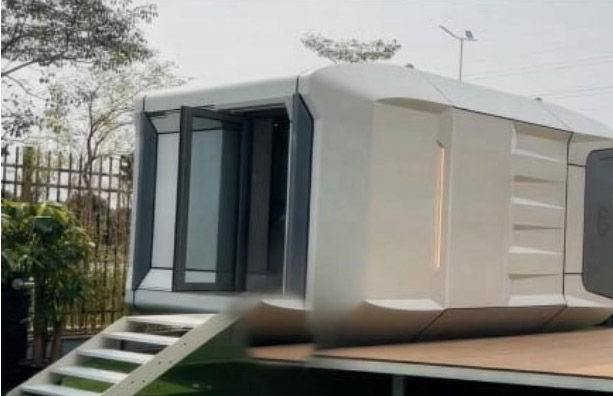Smart and Stylish efficient small house designs: The Best in Tiny House Architecture
- Blogger
- Aug 21
- 4 min read
Updated: Sep 10
Tiny houses have become a trend that marries creativity with sustainability. They not only provide an affordable option for housing but also exemplify a lifestyle that embraces minimalism. The concept of tiny houses has captivated many, encouraging individuals to rethink their living spaces. In this blog post, we will explore the world of capsule home designs and delve into innovative architecture that maximizes space without compromising on style or comfort.
Efficient Small House Designs
Efficient capsule home designs are the backbone of the tiny house movement. These designs emphasize functionality while ensuring that aesthetics are not sacrificed. When designing a tiny house, architects often focus on efficient layouts, smart storage solutions, and sustainable materials.
One of the standout examples of efficient capsule home designs is the Graham Hill's Tiny House. Located in Brooklyn, New York, this compact home is only 220 square feet, yet it features a kitchen, a living area that doubles as a bedroom, and even a workspace. Hill's home integrates foldable furniture and multi-use elements, showcasing how thoughtful design can lead to a highly functional living experience in limited square footage.

Statistics reveal that capsule house can reduce living expenses by up to 40 percent. This is due to lower utility bills and minimal maintenance costs. It’s worth considering whether downsizing could lead to greater financial freedom and a simplified lifestyle.
The Allure of Minimalism
Minimalism is at the core of small house architecture. The philosophy revolves around the idea that less is more. By eliminating unnecessary items and focusing on the essentials, people can enjoy a more fulfilling life.
Tiny houses encourage owners to declutter and curate their belongings. Many designs feature open floor plans, which create a sense of spaciousness. This not only improves functionality but also elevates the overall ambiance of the home.
Consider the Tumbleweed Tiny House Company, which creates small homes with a focus on simplicity. Each home is built from high-quality, sustainable materials, ensuring durability while promoting an eco-friendly lifestyle.

Sustainable Materials in Tiny House Architecture
Sustainability is a crucial component of tiny house architecture. Many architects prioritize the use of eco-friendly materials. This not only lessens the environmental impact but also enhances the home’s energy efficiency.
The use of reclaimed wood, recycled metals, and energy-efficient windows can significantly reduce a tiny home's carbon footprint. Additionally, many homes incorporate solar panels, which provide a sustainable energy source.
One inspiring example is the Kanga Room Systems, known for their prefabricated tiny homes that use sustainable building materials and energy-saving technologies. Their designs are not only aesthetically pleasing but also embody the principles of eco-conscious living.
Customization and Flexibility
Customizing a capsule house can turn it from a simple structure into a personalized sanctuary. Whether it's through custom cabinetry, innovative furniture, or unique color schemes, homeowners can infuse their personalities into designs.
Flexibility is also a key aspect of tiny home designs. Many capsule home allow for expandable features. For instance, foldable walls or retractable furniture can offer space-saving solutions without sacrificing comfort.
A notable example is the Tiny Heirloom, where homeowners can choose from a range of customizable features. These allow individuals to create a unique living space that meets their specific needs. Whether you want a sleeping loft, a porch, or even a washroom that doubles as a storage area, the options are plentiful.

Community and Tiny Living
Star Craft communities are sprouting across the globe, creating a sense of belonging among their inhabitants. These communities not only provide affordable housing options but also promote social interactions. Living in close quarters can foster friendships and shared experiences that traditional housing might lack.
Organizations like The star craft Community are establishing neighborhoods designed specifically for tiny homes. These communities often include shared amenities such as gardens, communal areas, and social events, enhancing the experience of tiny living.
Living close to others who share similar values of sustainability and minimalism can provide emotional support and create a network of like-minded individuals.
Innovations in Tiny House Architecture
As the trend of capsule house gains momentum, innovations in design and technology continue to emerge. From smart home technology to advanced insulation techniques, architecture is constantly evolving.
Smart home technologies, such as automated lighting and energy monitoring, can be incorporated into tiny homes. These innovations allow homeowners to manage their energy consumption and maintain comfort while maximizing efficiency.
A forward-thinking example is the Bungalow small capsule raw House, which utilizes IoT devices to optimize daily living. The integration of technology enhances the convenience of tiny living and offers new possibilities for automation within compact spaces.
As the world moves towards sustainable living, exploring efficient small house designs can lead to amazing discoveries. With many innovative options and a focus on minimalism, it's easy to see why small home are becoming more popular. Whether you're looking to downsize, reduce your environmental footprint, or simply enjoy a unique living experience, capsule houses can offer the perfect solution.
For more examples of intelligent architecture in the capsule home sector, be sure to check out related content on tiny house architecture. The world of tiny living is expansive and truly inspiring for anyone considering this transformative lifestyle.



Comments